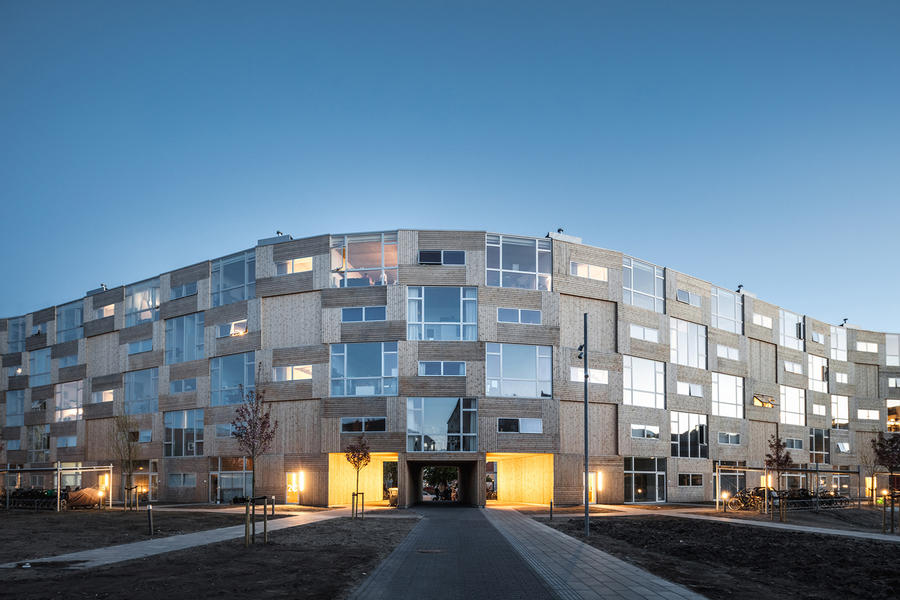In 2018, celebrated Danish architect Bjarke Ingels completed the Dortheavej Residence in Copenhagen, a residential development featuring his characteristically innovative touch. The building consists of prefabricated units stacked together to create a subtle checkerboard effect, all at angles that make the curved structure appear to undulate. It’s a striking example of Ingels’s work—made all the more interesting by the fact that it’s not a luxury complex aimed at architecture aficionados willing to shell out top dollar. No, the project, designed by one of the country’s most famous living architects, is low-income housing.

In America, meanwhile, low-income housing is largely designed to be ignored. Government-subsidized residences are created to be functional and durable, but almost never beautiful. It’s hard to imagine a government housing project in an American city being included on an architectural tour, like the Dortheavej Residence could well be. The idea of prioritizing function over form in this sector is something that interior designer Kia Weatherspoon, who spoke yesterday at Business of Home’s Future of Home conference, is trying to chip away at.
“The biggest hurdle, as I see it, is getting developers to understand that good design is not a luxury, it’s a necessity,” says Weatherspoon, whose Washington, D.C.–based firm Determined by Design was founded with the mission of bringing beautiful design to marginalized communities. Nine times out of 10, she says, developers contracted for affordable housing don’t use an interior design firm—not even as a consultant. “It usually takes one or two initial meetings with a developer on an affordable housing project to make the case for our work, to show them that I can do good design within their budget,” she says.
For the most part, many developers are too far removed from the end user to bring a lens of empathy to the project. “Our industry is very whitewashed, and it’s my belief that people don’t advocate for these communities because they don’t have a loved one who might live there,” says Weatherspoon. “I think that’s what it takes for someone to say, ‘This isn’t good enough.’ If your team isn’t diverse enough for you to take an empathetic view on this [type of work], that’s a problem. And that’s not to say that every designer of color has a connection to low-income communities, but they can understand it because it is primarily Black and brown people who are the end users of these developments.”

For example, Weatherspoon has been on projects where the developer was fighting for only uncomfortable hard surfaces or vinyl to be installed as seating in community areas. “And I say to them, ‘If your mother lived here, would you want there to be no soft seating for her to sit on?’ That’s also when we have a chance to explain how far performance fabric has come and how the technology on those textiles has evolved. It doesn’t have to be all vinyl to last.”
Convincing a developer of her value as an expert is just the first challenge. Once Weatherspoon lands the project, she has to not only design to an inflexible budget, but also comply with guidelines and requirements from the Department of Housing and Urban Development, which include a federal set of policies in addition to regulations that vary from state to state. At Future of Home, Weatherspoon gave the example of a requirement for high-use, industrial cabinetry in affordable housing apartments, a policy she says dates back nearly 40 years. Outdated requirements often wind up costing the developer more, as the materials can be harder to find and more expensive to source than modern ones.
“Manufacturing has changed and there’s a premium on these high-use cabinets,” she says. “If you have a building that has 125 units, that’s a lot of cabinetry; that’s a big-ticket item.” In addition to being pricey, heavy, box-style cabinets come with serious aesthetic constraints, as they usually only come in a certain door style or a few colors. “But there’s also an implication in that requirement that because these people are poor, they’re going to tear things up,” she adds.

Decades-old materials requirements such as these are, sadly, the norm in HUD housing. The quality standards for carpeting, for instance, haven’t been updated since 1993, which is actually fairly recent compared with the standard for wooden doors, which dates to 1975. For HUD-funded units, Weatherspoon is required to use plastic laminate countertops—another outdated material that isn’t just unattractive, it may also be less healthy than other options, as they can contain formaldehyde, which may cause cancer. “Indoor air quality is [negatively] impacted by materials like carpet and plastic laminate countertops as they age,” she explains.
The outright lack of care for inhabitants’ health is a disturbing trend across affordable American housing, one that’s been institutionalized by outdated, uninformed policies. A number of reports show that rates of chronic asthma are higher in low-income communities, a condition that a 2014 National Institutes of Health study directly attributes to low-quality housing. “These policies don’t consider the health and wellness of the residents,” says Weatherspoon. “Think about the year that we’ve all had and that there are people quarantined in low-income housing that was built 50 years ago that still has lead paint, that lacks energy efficiency or natural light. There are people living like that.”
Weatherspoon is passionate about bringing long-overdue change to HUD policies, but feels that the first step is for the wider A&D community to acknowledge the fundamental problem in how we approach affordable housing. “We need architects and designers to speak up and do their jobs,” she says. “Even if it’s not a sexy luxury project, you have to approach low-income or community-focused projects with the same zeal and integrity as you would a market-rate job. We’re just one firm with this mission, but this is something we all should be rallying around so that we can do better.”
Watch Kia Weatherspoon at the Future of Home conference here.



























